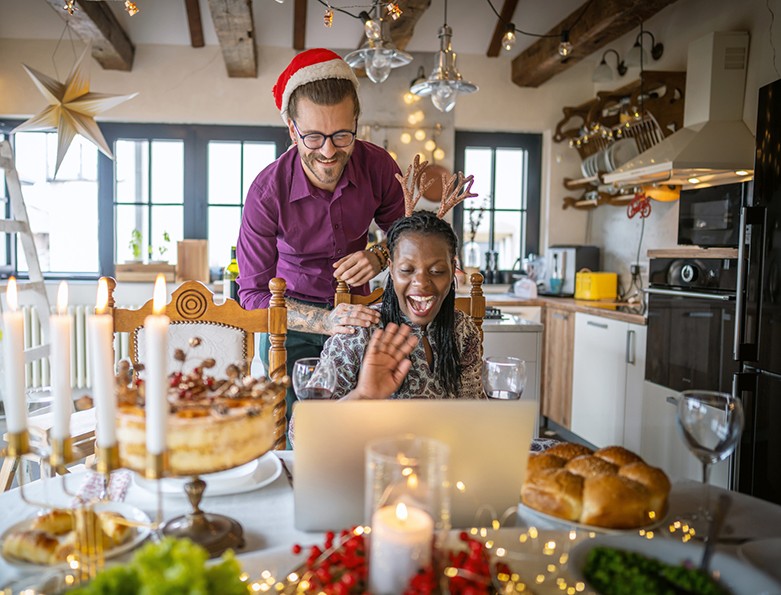The holiday season is a happy, magical time. The anticipation of celebrations and family gatherings gives many, especially children, a warm and happy excitement that they look forward to each year. Maintaining this tradition is important. This year, however, the COVID-19 pandemic may require families to adjust the way they celebrate, as public health experts warn that small household gatherings may be a key reason cases have recently surged nationally. The American Academy of Pediatrics encourages families to plan on how to be creative in celebrating the holidays while minimizing the risk of being exposed to or spreading COVID-19.
While shopping for presents is one of the central traditions in many families’ holiday celebration, shopping increases the risk of exposure to COVID. Alternatives to “store bought” gifts may be explored and can provide an opportunity for much joy and creativity. For example, parents may help their children make “home-made” gifts such as craft items, handwritten cards, baked goods, drawings or paintings, poems, memory books, etc.
Remembering that COVID has caused many families to experience financial hardship and food shortages may help put things in perspective. Reaching out to those in need, including immigrant and refugee groups who may be experiencing more barriers to safe and joyful holidays, and donating to charities and shelters may become part of a families’ new tradition of giving.
The American Academy of Pediatrics offers these suggestions:
- Consider limiting any in-person celebration to people who live in your household. Planning a special feast and cooking with your children and decorating your home are great ways to enjoy each other’s company.
- Think of creative ways to share the experience remotely. Consider preparing shared recipes at the same time over video chat. Keep the tradition of saying what you are grateful for, or set aside time to say grace together, for example.
- Consider a drop-off potluck. Another low-risk activity, according to the U.S. Centers for Disease Control and Prevention, is to prepare traditional recipes for family and neighbors. Instead of sharing them in person, delight them with a doorstep drop-off.
- Staying home is the best way to protect yourself and others. Grocery shop online with delivery and curbside pickup options if possible and consider delivering holiday food to older relatives. If you need to shop in-person, try to go at a time when stores are not as busy.
- Families who may be experiencing financial hardship and food shortage should reach out to local agencies or their pediatricians office. They may be able to connect families with resources to help with the holiday needs.
While it is not recommended, if you are gathering in person with anyone who has been living outside your household, be sure to take these steps to help lower the risk:
- Keep your guest list as small as possible and reduce the amount of time you would ordinarily visit.
- People from the same household can sit together, make people who don’t live together stay 6 feet apart–even while eating. Make sure everyone wears cloth face coverings whenever possible.
- If you are indoors, open windows for better ventilation. Better yet, if weather permits, gather outdoors (think Thanksgiving tailgating!). Remember to keep a safe distance apart from others and wear cloth face coverings even outside.
- Suggest guests bring their own food and drinks and choose one person to do the serving to avoid everyone touching serving utensils. Remind children to wash their hands often and keep hand sanitizer easily available.
- Make sure everyone follows safety steps beforehand. Ask your guests to be sure to wear cloth face coverings and practicing physical distancing for at least 14 days before the gathering. If anyone has been traveling—and certainly if anyone had or was exposed to COVID-19—try to self-quarantine for two weeks prior. This includes college students coming home from campus, especially if they go to school out of state.
If you must travel:
- Drive with family members in a private vehicle to avoid exposure to people outside your household if possible.
- Wear a mask when you leave your car (at gas stations and rest stops).
- Make meals ahead of time to avoid stops if possible.
- If you must travel by plane, be careful around security lines and crowded concourses to avoid large groups.
- If there is a crowd, wait until the line has thinned out if possible.
These times, while restrictive, can provide an opportunity for families to be creative and focus on what is important, tapping into their internal strengths and innate resilience. Including children in the discussion of why it is important to do things differently this year would be very helpful for them. “Invoking children’s’ sense of altruism and cooperation, explaining that by doing this we are doing our part in protecting “grandma and grandpa” and other people in the community and playing a role in the greater good of our community and country is an opportunity for building community awareness,” said Arwa Nasir, MBBS, MSc, MPH FAAP, a member of the AAP Committee on Psychosocial Aspects of Child and Family Health.
For parent resources on mental health, go to HealthyChildren.org: Keep the Holidays Happy During COVID-19
For general holiday safety tips beyond COVID-19 precautions, click here.



Leave A Comment